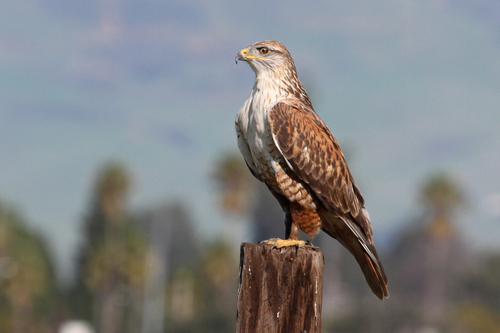
Ferruginous Hawk
The Ferruginous Hawk (*Buteo regalis*) is a majestic bird of prey native to the open grasslands and arid regions of North America. It is the largest hawk in North America. Known for its impressive size and powerful build, it plays a crucial role as a top predator, helping to regulate populations of rodents and other small mammals. Its name, "ferruginous," refers to the rusty (iron-like) color on the back and legs of light-morph birds. The species holds some cultural significance among certain Native American tribes, often symbolizing strength and vision.
56-69 cm
Length
122-152 cm
Wingspan
Least Concern
Conservation Status
Distribution
Primarily found in western North America, ranging from southern Canada (Alberta, Saskatchewan, Manitoba) through the western United States and into northern Mexico. They are partially migratory, with northern populations moving south for the winter.
Lifespan
Up to 20 years in the wild; potentially longer in captivity.
Ferruginous Hawk's Habitat
Habitat Types
Grasslands, Shrubsteppe, Deserts, Open woodlands, Agricultural fields (if suitable prey is available)
Climate Zones
Temperate, Arid, Semi-arid
Adaptations
Their broad wings are adapted for soaring over open country, allowing them to conserve energy while hunting. They have excellent eyesight for spotting prey from great distances. Their preference for open habitats is linked to their hunting style, which relies on spotting prey from above.
Variations
No recognized subspecies, although there is some variation in plumage color (light and dark morphs).
Appearance
Breeding Plumage
Plumage is similar year-round, but fresh plumage after molting may appear brighter.
Seasonal Feather Changes
Minimal seasonal variation.
Sex Based Plumage Differences
Adult males and females have similar plumage, but immatures differ. There are light and dark morphs.
Notable Features
Large size and broad wings, White belly (in light morph), Rusty-colored legs and back (in light morph), Dark morphs are chocolate brown, Feathered tarsi (legs)
Diet and Feeding
Primary Foods
Ground squirrels, Prairie dogs, Jackrabbits, Mice, Voles, Other small mammals, Occasionally birds and reptiles
Foraging Behavior
Primarily hunts by soaring and scanning the ground from above. Also hunts from perches, such as fence posts or utility poles. Occasionally hunts on the ground.
Specializations
Their large size and powerful talons allow them to take relatively large prey items compared to other hawks.
Seasonal Diet Variations
Diet shifts depending on prey availability. May focus on abundant, seasonally available prey like young ground squirrels in spring.
Behavior
Social Structure
Generally solitary or found in pairs during the breeding season. May congregate in loose groups during migration or at abundant food sources.
Communication
Vocalizations, including a 'kree-a' call, Aerial displays during courtship, Body postures to communicate threat or dominance
Migration
Northern populations are migratory, moving south to the southern U.S. and Mexico for the winter. Southern populations may be resident year-round.
Territorial or Group Behaviors
Highly territorial during the breeding season, defending nesting and hunting areas from other hawks and raptors.
Conservation
Threats
Habitat loss and degradation (due to agriculture, urbanization, and energy development), Prey depletion (due to poisoning of prairie dogs and ground squirrels), Shooting (illegal), Collisions with vehicles and power lines, Climate change (altering prey distribution and habitat suitability)
Protection Programs
Monitoring of populations, Habitat restoration and protection efforts, Public education to reduce persecution, Mitigation of threats from power lines (e.g., using bird-safe designs)
Local National Laws
Protected under the Migratory Bird Treaty Act in the United States, Canada, and Mexico.
Population Trend
Stable
Population Estimates
The global population is estimated to be around 70,000, with 14,000 in Canada, 55,000 in the United States, and 1,000 in Mexico.
Interesting Facts
They are the largest Buteo hawk in North America.
Their size allows them to take larger prey than smaller hawk species.
They have feathered legs down to their toes.
This is a characteristic shared with only two other North American hawks: the Rough-legged Hawk and the Golden Eagle.
They sometimes steal prey from other raptors.
This behavior, known as kleptoparasitism, supplements their own hunting efforts.
They often reuse the same nest for many years.
Nests can become quite large over time as the birds add new material each year.
Faqs about Ferruginous Hawk
What is the difference between a light morph and a dark morph Ferruginous Hawk?
The difference is in their plumage coloration. Light morphs have a white belly and rusty-colored back and legs, while dark morphs are mostly dark brown.
Are Ferruginous Hawks endangered?
No, they are currently listed as Least Concern by the IUCN, but they face several threats, and their populations have declined in some areas.
What should I do if I find an injured Ferruginous Hawk?
Do not approach the bird. Contact a local wildlife rehabilitation center or your state's wildlife agency for assistance. It is illegal to handle or possess these birds without the proper permits.
Where is the best place to see Ferruginous Hawks?
Ferruginous hawks prefer wide-open spaces. Look for them in grasslands, deserts, and agricultural areas in the western United States and Canada.
Copyright @ Nature Style Limited. All Rights Reserved.
 English
English